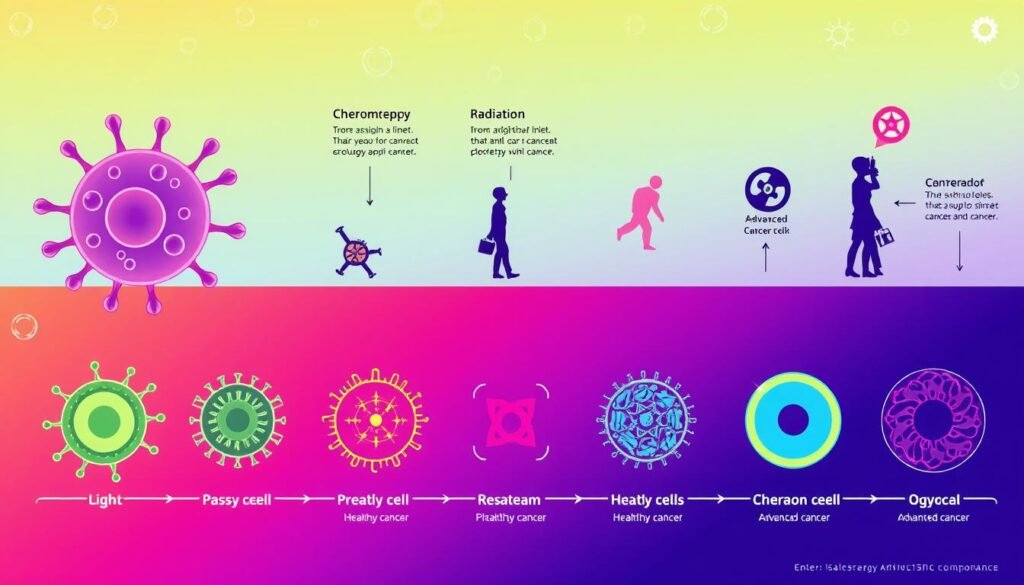By 2040, we could see 28.4 million cancer cases worldwide. This fact points out how crucial effective cancer treatments are. They should not just target tumors. Treatments must focus on managing symptoms and lifting survival rates too. People facing cancer need to know about their treatment options. This includes standard therapies like chemotherapy and newer methods that help in recovery.
The American Cancer Society emphasizes the need for a treatment plan that looks at overall outcomes. Patients and their families must decide on treatment methods. They also cope with cancer’s mental and emotional toll. Knowing about different treatments helps patients choose those that improve life quality. This article will look into managing symptoms and boosting survival rates with good treatments.
Key Takeaways
- Cancer treatment goes beyond targeting tumors, focusing on managing symptoms and improving quality of life.
- The global cancer burden is predicted to rise significantly by 2040.
- Effective management strategies can greatly enhance survival rates.
- Combining pharmacological and non-pharmacological therapies shows promising results for patients.
- Understanding treatment options, such as chemotherapy, is vital for informed decision-making.
Understanding Cancer Treatment Options
Cancer treatment varies widely, giving patients many paths to explore. These treatments include surgery, chemotherapy, and radiation, along with newer methods. The type and stage of cancer, and personal health, guide the treatment choice.
Overview of Traditional and New Treatments
Traditional therapies like surgery, chemotherapy, and radiation are key in cancer care. Surgery removes cancer, while chemotherapy and radiation attack cancer cells. New options include immunotherapy, which boosts the body’s fight against cancer, and targeted therapies that attack cancer cell functions. Patients might explore the latest through clinical trials. These offer new treatments with certain risks and benefits.
Complementary and Alternative Therapies
Complementary therapies help manage symptoms and improve life quality. They include acupuncture, yoga, and dietary changes to lessen side effects like pain and nausea. While not replacing standard care, they add benefits to treatment plans. It’s wise for patients to discuss complementary therapies with their healthcare team for coordinated care focusing on well-being.
Role of Chemotherapy in Cancer Treatment
Chemotherapy is key in cancer treatment. It aims to halt or slow cancer cell growth. This depends on the patient’s unique condition. The main goals are to cure, control, or ease symptoms. The chosen chemotherapy drugs depend on these goals.
How Chemotherapy Works
Chemotherapy targets fast-growing cancer cells. It uses chemotherapy drugs to stop cells from growing and dividing. Treatment cycles are tailored to the patient’s health and weight. This ensures the treatment is effective and risks are low. Doctors adjust the treatment if side effects are too strong.
Common Types of Chemotherapy Drugs
There are many kinds of chemotherapy drugs. Here are some common ones:
- Alkylating Agents: These drugs damage cancer cell DNA to stop them from dividing.
- Anti-Metabolites: They block cell growth by imitating DNA or RNA components.
- Plant Alkaloids: Coming from plants, these drugs halt cell division.
Chemotherapy can be the only treatment or used with others like radiation or immunotherapy. Knowing the cancer’s type and stage helps choose the best treatment. For more info on chemotherapy, check this resource.

Chemotherapy Side Effects and Their Management
Chemotherapy is a key part of fighting cancer, but it often has side effects. Knowing these effects helps patients and caregivers. They can be physical and emotional, making it important to recognize them early.
Physical Side Effects
Chemotherapy can lead to several physical side effects. These include:
- Fatigue
- Hair loss, starting usually within three weeks
- Nausea and vomiting, seen in up to 80% of patients
- Anemia, leading to more fatigue
- Easily bruising and bleeding
- Higher risk of infections
- Mouth sores and sore throat
- Constipation and diarrhea
- Neuropathy, with pain or tingling in hands or feet
Everyone reacts differently to chemotherapy. Some people might have mild symptoms, others more severe. It’s essential to talk to your doctors about your symptoms for prompt help.
Emotional and Psychological Impact
Chemotherapy’s emotional toll is also big. Patients often feel:
- Anxiety about treatment and getting better
- Depression from the physical changes and treatment challenges
- Stress over lifestyle changes and money worries
These feelings can make it harder to get through treatment. Knowing this helps in taking care of your emotional health.
Strategies for Managing Side Effects
Managing side effects is crucial for a good life during chemotherapy. Here are some tips:
- Follow your doctor’s advice on medications for nausea or pain.
- Join counseling or support groups.
- Do gentle exercises to help with fatigue and improve mood.
- Ask your doctor before starting any vitamins or supplements.
- Eat well and drink plenty of fluids to control symptoms.
Being proactive helps a lot in dealing with side effects. Always tell your cancer team about any new or worsening symptoms for the best support.
Survival Rates and Symptom Management Through Chemotherapy
Understanding survival rates helps in setting expectations and creating treatment plans. These rates show how long people typically live after being diagnosed with specific cancers. They point out why managing symptoms well can improve life quality and treatment success.
Understanding Survival Rates
Survival rates are divided in different ways:
- Cancer-specific survival: This is the percent of patients who haven’t died from their cancer after a set time.
- Relative survival: This compares the survival rates of those with cancer to people without it over some time.
- Overall survival: This is the percent of patients alive after any cause over a certain period.
- Disease-free survival: This shows patients with no cancer signs after treatment.
The Importance of Symptom Control
Managing symptoms well is key to better living for patients. Over 60% of young cancer survivors still face long-term effects from their disease or its treatment. Tackling these issues can boost both mental and physical health, leading to improved survival odds. Having strong support networks also helps in dealing with chemotherapy challenges.
Current Statistics on Survival Rates
The survival rates vary with the type and stage of cancer. The NCI reports over 630,000 young survivors in the U.S. These numbers are expected to rise from 15.5 million survivors in 2016 to over 26 million by 2040. The Cancer Moonshot initiative, supported by the STAR Act, aims to better survivor resources and outcomes.

| Cancer Type | 5-Year Survival Rate (%) | Current Statistics Source |
|---|---|---|
| Pediatric Cancers | Over 80% | NCI |
| Breast Cancer | 90% | American Cancer Society |
| Prostate Cancer | 98% | National Cancer Institute |
| Lung Cancer | 20% | American Cancer Society |
| Colon Cancer | 64% | NCI |
The Impact of Disease Progression on Treatment Outcomes
Disease progression means cancer is growing or spreading. This greatly affects how well treatments work for patients. Understanding this process helps doctors create better treatment plans. It’s very important to know the difference between stable and progressive disease. This helps in seeing if treatments are effective and deciding what to do next.
Definitions of Disease Progression
There are two main types of disease progression: stable disease (SD) and progressive disease (PD). In research on breast cancer treatment, 91% of patients saw a decrease in their cancer with treatment. Only 6% had their disease stay the same. Meanwhile, 3% saw their cancer grow during their treatment. This shows how hard managing cancer can be.
Coping with Disease Recurrence
Dealing with cancer coming back is very tough emotionally and mentally for patients. Changes often have to be made to their treatment plans. For those whose cancer got worse during treatment, 68% chose to have a mastectomy. Another 20% went with a surgery that saves as much of the breast as possible. These changes highlight why patients need ongoing information on their treatment choices.

The American Cancer Society says many people will die from cancer each year. Knowing about disease progression and how to deal with cancer coming back is crucial. It helps patients and their families through their health journey. While managing cancer is hard, it can be easier with the right information and support from healthcare teams.
Palliative Care: Enhancing Quality of Life
Palliative care is vital for people with serious illnesses. It aims to ease symptoms and offer support. This is true whether a cure is possible or not. It meets physical, emotional, and spiritual needs to boost well-being.
Understanding Palliative Care
Palliative care is not just for those at the end of life. It starts at diagnosis, focusing on comfort. Studies show it can improve mood and even help patients live longer.
Differentiating Palliative from Hospice Care
Palliative and hospice care are different. Hospice is for end-of-life. But palliative care helps anyone in their illness journey. It ensures comfort and support at any illness stage.
Integrating Palliative Care into Treatment Plans
Adding palliative care to cancer treatment helps manage symptoms. Experts like the American Society of Clinical Oncology suggest it for those with advanced cancer. Patients often feel better and less depressed with it.
Many health insurance plans cover palliative care. Private insurances, Medicare, and Medicaid often help. Early palliative care can also cut healthcare costs. It leads to fewer hospital visits and better symptom control.
Patient Outcomes: What to Expect During and After Treatment
Understanding outcomes during and after cancer treatment is key for realistic expectations. Many factors influence these outcomes, such as cancer type and health. It’s important for patients to talk about their concerns with their healthcare team.
Factors Affecting Patient Outcomes
Many factors impact the chance of beating cancer or it coming back:
- Cancer Type: Recovery and outcomes can vary greatly by cancer type.
- Stage of Cancer: Early detection often leads to better outcomes.
- Individual Health: A patient’s overall health affects how they handle treatment.
- Response to Treatment: Some patients get better quickly, others may take longer.
The Journey Through Remission and Recurrence
Remission is a hopeful time. It means treatment has worked and cancer can’t be found. Yet, it’s vital to know that cancer can return. Follow-up care helps catch any signs early.
Everyone’s experience with treatment like chemotherapy is different. Side effects like tiredness and feeling sick are common. These don’t mean the treatment is unsuccessful.
Looking into other cancer treatments such as radiation therapy can offer more options. Patients can learn about complementary strategies in their treatment plans.
| Factor | Description |
|---|---|
| Cancer Type | Different treatments work better for different types of cancer. |
| Cancer Stage | The earlier the cancer is found, the better the chances of a good outcome. |
| Individual Health | How healthy a patient is can affect how well they recover. |
| Response to Treatment | How fast and well a treatment works can vary. |
By knowing about factors that affect outcomes, people can talk openly with doctors and follow treatment plans well. This is crucial for the best health results.
Support Systems for Cancer Patients
Having a strong support system is vital during the cancer treatment journey. Family members provide both emotional and practical help. This makes dealing with treatment side effects easier. Besides family, professional support also makes a big difference in the patient’s experience.
The Role of Family and Friends
Family and friends create a nurturing environment that is essential for cancer patients. They help reduce feelings of loneliness and despair. With their emotional support, patients often feel stronger and more ready to face challenges. It’s key for families to learn about the illness to support effectively. This knowledge fosters open conversations about fears, strengthening family ties.
Support Groups and Professional Help
Support groups are a key resource for people with cancer. They offer a space to share experiences and coping methods. Counseling services provide crucial one-on-one support through programs like ACS CARES™. There are also specialized support groups for different cancer types and treatment stages. This lets individuals connect with others who truly understand their journey.
- Programs like The Road To Recovery offer transportation solutions for those needing assistance getting to treatment.
- Reach To Recovery connects breast cancer patients with trained survivors for mentorship and support.
- Online communities like the Cancer Survivors Network help patients and caregivers connect beyond in-person meetings.
- People might find free or low-cost counseling at hospitals and clinics, especially if they’re facing financial challenges.
The American Cancer Society works hard to promote support systems through their 24/7 helpline. Using these resources can significantly improve life quality for patients and their families in tough times.
Conclusion
Cancer treatment is not just about the medical side. It includes managing symptoms and knowing survival odds. Recent numbers show most patients start with parenteral chemotherapy. Unfortunately, about 66.4% face disease progression. This fact shows how critical symptom control is during these tough times.
Patients and their families need ongoing support. Emotional and educational help is key. Knowing about care options, like palliative care, can change outcomes. For example, 85% of chemotherapy treatments aim to ease symptoms. Talking with doctors is important to tackle worries and needs. Over 66% of patients deal with fatigue. This highlights the importance of managing symptoms well.
Being compassionate and understanding improves patients’ experiences with cancer. Treatment advances offer hope for better survival rates. This encourages talks on symptom management and quality care. With the right information and support, people can face their cancer journey better.